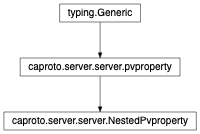caproto.server.server.NestedPvproperty¶

-
class
caproto.server.server.NestedPvproperty(get: Optional[caproto.server.typing.Getter] = None, put: Optional[caproto.server.typing.Putter] = None, startup: Optional[caproto.server.typing.Startup] = None, shutdown: Optional[caproto.server.typing.Shutdown] = None, *, scan=None, name: Optional[str] = None, dtype: Optional[Type[T_Data]] = None, value: Optional[Any] = None, max_length: Optional[int] = None, alarm_group: Optional[str] = None, doc: Optional[str] = None, read_only: Optional[bool] = None, field_spec: Optional[caproto.server.server.FieldSpec] = None, fields: Optional[Tuple[Tuple[Tuple[str, str], Union[caproto.server.typing.Getter, caproto.server.typing.Putter, caproto.server.typing.Startup, caproto.server.typing.Shutdown, caproto.server.typing.Scan]], …]] = None, record: Optional[Union[str, Type[T_RecordFields]]] = None, **cls_kwargs)[source]¶ Nested pvproperty which allows decorator usage in parent class
Without using this for the SubGroups, using @subgroup.prop.getter causes the parent class to see multiple pvproperties - one defined on the subgroup, and one returned from pvproperty.getter. This class fixes that by returning the expected class - the parent (i.e., the subgroup)
- Bonus points if you understood all of that.
… scratch that, bonus points to me, I think.
Methods
from_pvspec(pvspec, parent)Create a pvproperty from a PVSpec instance.
getter(get)Usually used as a decorator, this sets the
getterin the PVSpec.putter(put)Usually used as a decorator, this sets the
putterin the PVSpec.scan(*args, **kwargs)Periodically call a function to update a pvproperty.
shutdown(shutdown)Usually used as a decorator, this sets
shutdownin the PVSpec.startup(startup)Usually used as a decorator, this sets
startupin the PVSpec.Attributes
fieldsrecord_typeThe configured record type to report.